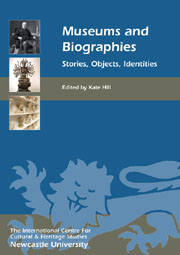Book contents
- Frontmatter
- Contents
- List of Illustrations
- Introduction: Museums and Biographies – Telling Stories about People, Things and Relationships
- INDIVIDUAL BIOGRAPHY AND MUSEUM HISTORY
- PROBLEMATISING INDIVIDUALS' BIOGRAPHIES
- INSTITUTIONAL BIOGRAPHIES
- 7 Significant Lives: Telling Stories of Museum Architecture
- 8 Schinkel's Museums: Collecting and Displaying Architecture in Berlin, 1844–1933
- 9 Personifying the Museum: Incorporation and Biography in American Museum History
- 10 Making an Exhibition of Ourselves
- 11 Institutional Autobiography and the Architecture of the Art Museum: Restoration and Remembering at the National Gallery in the 1980s
- OBJECT BIOGRAPHIES
- MUSEUMS AS BIOGRAPHY
- MUSEUMS AS AUTOBIOGRAPHY
- Endpiece: The Homunculus and the Pantograph, or Narcissus at the Met
- List of Contributors
- Index
11 - Institutional Autobiography and the Architecture of the Art Museum: Restoration and Remembering at the National Gallery in the 1980s
from INSTITUTIONAL BIOGRAPHIES
Published online by Cambridge University Press: 05 February 2013
- Frontmatter
- Contents
- List of Illustrations
- Introduction: Museums and Biographies – Telling Stories about People, Things and Relationships
- INDIVIDUAL BIOGRAPHY AND MUSEUM HISTORY
- PROBLEMATISING INDIVIDUALS' BIOGRAPHIES
- INSTITUTIONAL BIOGRAPHIES
- 7 Significant Lives: Telling Stories of Museum Architecture
- 8 Schinkel's Museums: Collecting and Displaying Architecture in Berlin, 1844–1933
- 9 Personifying the Museum: Incorporation and Biography in American Museum History
- 10 Making an Exhibition of Ourselves
- 11 Institutional Autobiography and the Architecture of the Art Museum: Restoration and Remembering at the National Gallery in the 1980s
- OBJECT BIOGRAPHIES
- MUSEUMS AS BIOGRAPHY
- MUSEUMS AS AUTOBIOGRAPHY
- Endpiece: The Homunculus and the Pantograph, or Narcissus at the Met
- List of Contributors
- Index
Summary
This chapter explores some of the ways in which art museums speak with and about their own pasts through focusing historically on events at the National Gallery in the 1980s and 1990s. The ongoing revalorisation of Victorian interiors within museums which commenced in those decades has led to a spate of restoration projects. These ostensibly reverse the modernist project of stripping away (or, more accurately, overlaying) Victorian features. Such restorations re-inscribe a heritage of Victorian museology into the modern-day art museum as a building and as an institution. What emerges is a special kind of institutional autobiography in which the art museum's relationship to its own past is literally fabricated, negotiating tense connections and effecting considered disconnections between shifting values, ideals and social and intellectual projects over the different chapters of institutional and cultural life. After all, as Tim Barringer has noted, museums like the National Gallery in London ‘stand in complex and sometimes tormented relation to the Victorian epistemologies which produced them’ (2006, 133). The ‘restoration’ of the late 19th-century Barry Rooms at the National Gallery in the 1980s provides a case study of the politics involved in such projects, in which the balance between the preservation and the construction of the gallery's physical past is delicate. The project also involved encounters with complex issues relating to the concept of authenticity and to decisions about which period of the building's architectural history should be privileged and which should be literally hidden from view or excised, presenting questions about the veracity of the institutional history written not in text but, as it were, on the walls, in ceilings and in décor.
- Type
- Chapter
- Information
- Museums and BiographiesStories, Objects, Identities, pp. 157 - 170Publisher: Boydell & BrewerPrint publication year: 2012



